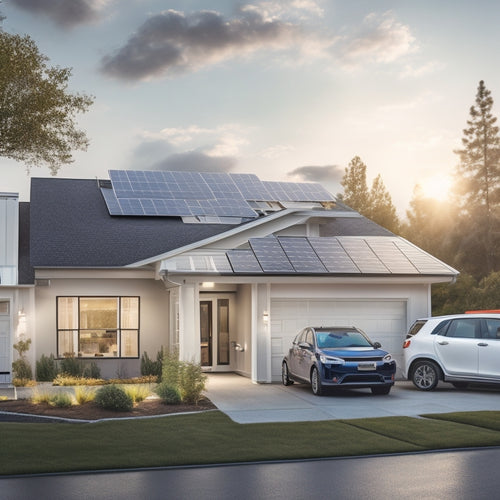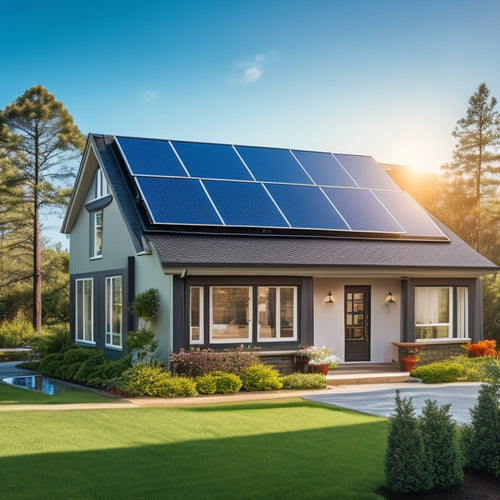
Boost Home Energy Efficiency With Top Panels
Share
By investing in top-tier solar panels with high efficiency ratings, you can greatly enhance your home's energy efficiency, reducing your reliance on the grid and cutting your energy bills by up to $1,000 per year. Look for panels with efficiency rates exceeding 20% and low temperature coefficients for peak performance. High-quality panels with advanced cell materials and bifacial designs can further boost energy output. Learn how to optimize your solar panel installation, maintenance, and energy efficiency strategies to maximize your savings and environmental benefits, and discover more about the latest solar panel technologies that can take your home's energy efficiency to the next level.
Key Takeaways
• Choose high-efficiency solar panels with ratings between 15% to 22% to maximize energy output and reduce carbon footprint.
• Upgrade to energy-efficient appliances and lighting to reduce energy consumption and enhance overall home energy efficiency.
• Conduct an Energy Audit to identify energy-wasting areas and implement targeted improvements for significant energy savings.
• Ensure proper residential solar panel installation, including correct system size and inverter type, to optimize energy production.
• Regularly clean and inspect solar panels to maintain optimal energy output and prolong their lifespan.
Top Energy-Efficient Solar Panels
Maximizing your home's energy efficiency starts with selecting high-quality energy-efficient solar panels, which convert sunlight into electricity with minimal waste and impressive efficiency rates, often exceeding 20%.
When choosing the best panels for your home, consider those with high-efficiency rates, durable materials, and reliable performance. You'll want to look for panels with a high power output per unit area, low temperature coefficients, and a strong warranty. These premium panels will help you generate more electricity and reduce your reliance on the grid.
But, did you know that solar farms, which are large-scale solar power generation facilities, use the same technology to generate electricity on a massive scale? Similarly, energy storage systems, like batteries, can store excess energy generated by your solar panels for later use.
Benefits of Residential Solar Energy
By installing residential solar energy, you're not only decreasing your carbon footprint but also accessing a plethora of financial and environmental benefits that can enhance your lifestyle and the planet's well-being.
One of the most significant advantages of residential solar energy is Energy Independence. With solar panels, you're no longer reliant on the grid, and you can generate your own clean energy. This means you'll be immune to rate hikes and enjoy lower electricity bills.
Here's a breakdown of the benefits:
| Benefits | Description |
|---|---|
| Energy Savings | Reduce your electricity bills by up to 50% |
| Carbon Footprint | Decrease your carbon emissions and contribute to a cleaner environment |
| Increased Property Value | Boost your property value by up to 17% with solar installations |
Solar Panel Efficiency Ratings Explained
You'll want to grasp solar panel efficiency ratings to guarantee you're getting the most out of your residential solar energy system. Think of it like buying a car - you want to know the mileage, right? Same idea here.
Efficiency ratings measure how well a panel converts sunlight into electricity. It's calculated by dividing the maximum power output by the total sunlight energy hitting the panel. The higher the rating, the more efficient the panel.
Panel grading is important because it directly affects your energy production. Look for ratings between 15% to 22%, with higher being better. Some top-tier panels boast efficiencies above 23%!
Energy metrics like wattage, voltage, and amperage also matter. Understanding these metrics ensures you're getting the right panel for your energy needs.
When shopping for panels, keep an eye out for certifications like the International Electrotechnical Commission (IEC) or UL (Underwriters Laboratories) marks. These guarantee the manufacturer's efficiency claims are accurate.
Advantages of High-Efficiency Panels
When you opt for high-efficiency panels, you can expect significant benefits that impact your energy consumption and budget.
You'll enjoy guaranteed energy savings, thanks to the improved performance of these advanced panels.
Additionally, you'll experience enhanced power output and durability, ensuring a reliable and long-lasting energy solution for your home.
Energy Savings Guaranteed
High-efficiency panels guarantee significant reductions in your energy consumption, translating to substantial cost savings on your utility bills. You'll be thrilled to know that these high-quality panels can slash your energy expenses by up to 50%!
But that's not all - you can also reap the benefits of government incentives designed to encourage eco-friendly upgrades. Take advantage of tax credits, rebates, and other perks that'll help offset the initial investment.
Before installing high-efficiency panels, consider conducting an energy audit to pinpoint areas of energy inefficiency in your home. This important step will help you identify the most effective ways to optimize your energy usage.
Enhanced Power Output
By upgrading to high-efficiency panels, your home can harness more energy from the same amount of sunlight, resulting in a significant boost to your overall power output. This means you'll generate more electricity without increasing your carbon footprint, which is a win-win for the environment.
With high-efficiency panels, you'll reduce your reliance on the grid and minimize your climate impact. Plus, you can store excess energy in batteries for later use, thanks to advanced energy storage systems. This setup allows you to power your home even during nighttime or on cloudy days.
High-efficiency panels are designed to optimize energy production, even in low-light conditions. They're perfect for homes with limited roof space or those in areas with frequent cloud cover. By maximizing your energy output, you'll reduce your electricity bills and enjoy a faster return on investment.
Durability Ensured
Your investment in high-efficiency panels is safeguarded by their robust design, which guarantees they can withstand harsh weather conditions and last longer than traditional panels.
You can breathe a sigh of relief, knowing that your investment is protected from the elements. High-efficiency panels boast exceptional weather resistance, ensuring they can handle whatever Mother Nature throws their way. Whether it's scorching heat, torrential rains, or freezing temperatures, these panels are built to last.
This durability is backed by a longevity guarantee, giving you peace of mind and protecting your wallet. With high-efficiency panels, you can expect a lifespan of 25 years or more, compared to the 15-20 years of traditional panels.
This extended lifespan means you'll enjoy more years of energy savings and a lower carbon footprint. So, go ahead and make the switch to high-efficiency panels – your wallet and the planet will thank you!
Residential Solar Panel Installation
You'll reap the benefits of renewable energy and reduce your reliance on the grid when you install solar panels on your residential property. With a residential solar panel installation, you'll not only reduce your carbon footprint but also save on energy costs.
But before you start, it's crucial to take into account a few key factors.
Here are some key considerations for a successful residential solar panel installation:
-
Roof Integration: Make sure your roof is structurally sound and compatible with solar panels. You may need to replace your roof or perform repairs before installation.
-
Solar Insurance: Invest in insurance that covers your solar panels against damage, theft, or other risks.
-
System Sizing: Determine the correct system size based on your energy needs and available roof space.
-
Inverter Selection: Choose the right inverter type for your system, considering factors like efficiency, reliability, and warranty.
-
Local Building Codes: Familiarize yourself with local building codes, permits, and regulations to avoid any installation delays.
Energy Savings With Solar Power
With a well-designed solar panel system, homeowners can greatly reduce their energy bills and enjoy long-term savings.
You'll be harnessing the power of the sun to generate electricity, which means you'll be relying less on the grid and more on Mother Nature. This not only saves you money but also reduces your carbon footprint.
Plus, with solar incentives like tax credits and rebates, the initial investment in your solar panel system becomes more affordable. You'll be rewarded for going green!
Solar Panel Technology Updates
As you explore the latest advancements in solar panel technology, you'll discover significant improvements in cell design that boost energy output.
You'll also learn about the benefits of bifacial panels, which can increase energy production by up to 25%.
Additionally, you'll get an overview of perovskite solar cells, a promising new material that could further reduce the cost of solar energy.
Advancements in Cell Design
Solar cells have undergone significant transformations in recent years, driven by innovations in photovoltaic technology that have vastly improved their energy-harvesting capabilities.
As you explore the latest advancements in cell design, you'll discover how these innovations have led to more efficient and effective solar panels.
Here are some key developments that have contributed to this progress:
-
Thinner wafers: Reducing the thickness of silicon wafers has increased energy output while decreasing production costs.
-
Quantum Dots: These tiny crystals can be tuned to specific wavelengths, enhancing energy absorption and conversion.
-
Advanced Cell Materials: New materials like perovskites and organic photovoltaics offer improved efficiency and lower production costs.
-
Multi-junction cells: Stacking multiple layers of cells with different bandgaps allows for more efficient energy harvesting across the solar spectrum.
-
Nanostructured surfaces: Textured surfaces and nanostructures can increase energy absorption and reduce reflection losses.
These advancements have paved the way for more efficient, affordable, and sustainable solar panels.
Bifacial Panel Benefits
You're likely familiar with traditional solar panels, which only harness energy from the front side, but bifacial panels take it to the next level by capturing light from both the front and back sides, resulting in increased energy output.
This innovative technology boosts your home's energy efficiency, and it's not just about the numbers – it's also about the aesthetics. Bifacial panels often feature a sleek, frameless design that blends seamlessly into your roof, making them a stylish choice for homeowners.
But what about rural applications? Bifacial panels shine in these settings, where the reflective properties of snow, water, or sand can amplify energy production. Imagine harnessing the power of the sun on a snowy rural rooftop, or near a serene lakefront property – it's a match made in heaven!
With bifacial panels, you can tap into this potential and enjoy increased energy yields. So, why settle for traditional panels when you can have it all with bifacial technology?
Perovskite Solar Cells
Researchers have made significant strides in Perovskite Solar Cells, a next-generation technology that's rapidly closing the efficiency gap with traditional silicon-based panels, boasting power conversion rates of over 23%.
You're probably wondering what makes these cells so special. For starters, Perovskite crystals have a unique crystal structure that allows for better light absorption, resulting in higher energy yields.
Here are some key benefits of Perovskite Solar Cells:
-
Scalable manufacturing: Perovskite cells can be produced using low-cost, solution-based methods, making them a more affordable option.
-
High power conversion rates: Perovskite cells have shown power conversion rates of over 23%, rivaling traditional silicon-based panels.
-
Flexibility: Perovskite cells can be flexible, making them ideal for non-traditional applications like wearable technology or building-integrated photovoltaics.
-
Tunability: Perovskite crystals can be tuned to respond to specific wavelengths of light, allowing for more efficient energy harvesting.
-
Low toxicity: Perovskite materials are non-toxic and environmentally friendly, reducing the environmental impact of solar energy production.
With their impressive performance and scalability, Perovskite Solar Cells are poised to revolutionize the solar energy industry. As research continues to advance, you can expect to see these cells become more prevalent in the market.
Increasing Home Energy Efficiency
By upgrading to energy-efficient appliances and lighting, homeowners can greatly reduce their energy consumption and lower their utility bills. You might be surprised at how much of a difference it can make!
But that's not all - there are many other ways to boost your home's energy efficiency. For instance, don't forget to check your home's insulation. Proper Home Insulation can make a significant impact on your energy consumption. It's like wearing a cozy sweater on a cold winter day - your home will stay warm and toasty, and you'll be saving energy in the process!
Another vital step in increasing your home's energy efficiency is conducting an Energy Audit. This is like doing a health check-up for your home - it helps identify areas where energy is being wasted and provides you with a roadmap to make improvements. By identifying energy-sucking culprits like air leaks and inefficient HVAC systems, you can make targeted improvements to maximize your energy savings.
Residential Solar Panel Maintenance
Properly maintaining your residential solar panels is crucial to guaranteeing they operate at peak performance, with even a 1% decrease in efficiency translating to a significant loss in energy production.
You invested in solar panels to save energy and reduce your carbon footprint, so don't let neglect hinder their performance.
To keep your panels running smoothly, remember to:
-
Schedule regular Panel Cleaning to remove dirt and debris that can reduce energy output
-
Perform a Seasonal Inspection to identify and address any potential issues before they become major problems
-
Trim nearby trees or plants to make sure they don't cast shade on your panels
-
Check for loose connections and tighten them as needed
-
Monitor your energy production and consumption to detect any unusual patterns or drops in efficiency
Solar Panel Cost and Savings
You can expect significant long-term savings on your energy bills, with the average homeowner saving between $400 and $1,000 per year, depending on the size of the solar panel system and the local electricity rates. That's a nice chunk of change you can allocate to other areas of your energy budget!
When it comes to the upfront cost of solar panels, it's true that the initial investment can be steep. However, with federal incentives like the Solar Investment Tax Credit (ITC), you can claim a significant portion of the cost back as a tax credit. This can help offset the initial expense and make the switch to solar more affordable.
Think of it this way: every dollar you save on energy bills is a dollar you can put towards something more fun – like a summer road trip or a fancy dinner. And with solar panels, you'll be reducing your carbon footprint while padding your wallet.
Frequently Asked Questions
Can I Install Solar Panels on a Metal or Clay Tile Roof?
'You'll need to prep that metal or clay tile roof before installing solar panels. Start with a thorough roof inspection, then remove tiles as needed, and finally, strategically place panels for maximum energy harvesting.'
Do Solar Panels Generate Electricity During a Power Outage?
"You won't have power during an outage with standard solar panels, but don't worry! With the right setup, you can achieve grid independence and energy security, ensuring you're not left in the dark - literally!"
Can I Add More Panels to My Existing Solar Panel System?
You're wondering if you can add more panels to your existing solar panel system? Absolutely! A system upgrade can increase your energy output, and it's a great way to boost your renewable energy production without starting from scratch.
How Long Does It Take to Install a Residential Solar Panel System?
You're wondering how long it takes to install a residential solar panel system? Typically, the permitting process takes 2-4 weeks, and the installation timeline is 2-5 days with a crew size of 2-5 people, depending on site preparation complexity.
Are Solar Panels Resistant to Hail and Extreme Weather?
You're wondering if solar panels can withstand Mother Nature's tantrums? Yes, they're designed to be weather-resistant and storm-durable, with most panels tested to resist hail up to 25mm in diameter and extreme weather conditions.
Related Posts
-

What Electric Vehicle Owners Need for Home Energy
As an electric vehicle owner, you need to optimize your home energy system to guarantee efficient, sustainable, and c...
-

Top 10 Tips for Buying Car Accessories Online
When purchasing car accessories online, you should take proactive steps to avoid low-quality or incompatible products...
-

Solar Power Units Perfect for Homes
You're considering installing a solar power unit in your home, a decision that can notably reduce your reliance on tr...


